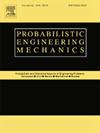Improved conditional random field simulation method based on bootstrap- Bayesian inference and its application in identification of seafloor liquefaction
IF 3.5
3区 工程技术
Q2 ENGINEERING, MECHANICAL
引用次数: 0
Abstract
The reasonable determination of correlation distances serves as the prerequisite for ensuring the accuracy of random field simulation results for geotechnical parameters, and also constitutes a critical challenge in random field simulations that remains difficult to resolve. The Bootstrap method was employed to perform resampling on correlation distances. Utilizing the sampling results, a weighted prior probability density function for correlation distances was constructed. By applying Bayesian principles in conjunction with Hoffman's conditional random field simulation method, the decoupling and simultaneous updating of correlation distance determinations and geotechnical parameter estimations in random field simulations were achieved. Taking a seabed site as an example, this study simulated the spatial variability of marine soil SPT-N values and their influence on seabed liquefaction probability. The research revealed the impacts of correlation distances, constraints from measured borehole data, and heterogeneity of original site stratigraphy on random field simulation outcomes and seabed liquefaction probability. The validity of the proposed methodology was confirmed through verification against reserved measurement results at actual borehole locations.
基于自举贝叶斯推理的改进条件随机场模拟方法及其在海底液化识别中的应用
合理确定相关距离是保证土工参数随机场模拟结果准确性的前提,也是随机场模拟中一直难以解决的关键难题。采用Bootstrap方法对相关距离进行重采样。利用采样结果,构造相关距离加权先验概率密度函数。将贝叶斯原理与Hoffman条件随机场模拟方法相结合,实现了随机场模拟中相关距离确定与岩土参数估计的解耦和同步更新。以某海底场地为例,模拟了海洋土壤SPT-N值的空间变异性及其对海底液化概率的影响。研究揭示了相关距离、实测井眼数据约束和原址地层非均质性对随机场模拟结果和海底液化概率的影响。通过与实际井眼位置的保留测量结果进行验证,证实了所提出方法的有效性。
本文章由计算机程序翻译,如有差异,请以英文原文为准。
求助全文
约1分钟内获得全文
求助全文
来源期刊

Probabilistic Engineering Mechanics
工程技术-工程:机械
CiteScore
3.80
自引率
15.40%
发文量
98
审稿时长
13.5 months
期刊介绍:
This journal provides a forum for scholarly work dealing primarily with probabilistic and statistical approaches to contemporary solid/structural and fluid mechanics problems encountered in diverse technical disciplines such as aerospace, civil, marine, mechanical, and nuclear engineering. The journal aims to maintain a healthy balance between general solution techniques and problem-specific results, encouraging a fruitful exchange of ideas among disparate engineering specialities.
 求助内容:
求助内容: 应助结果提醒方式:
应助结果提醒方式:


